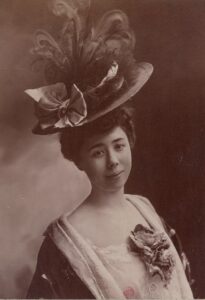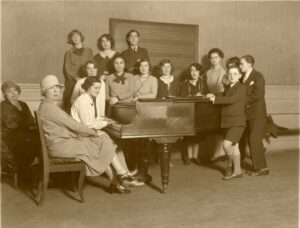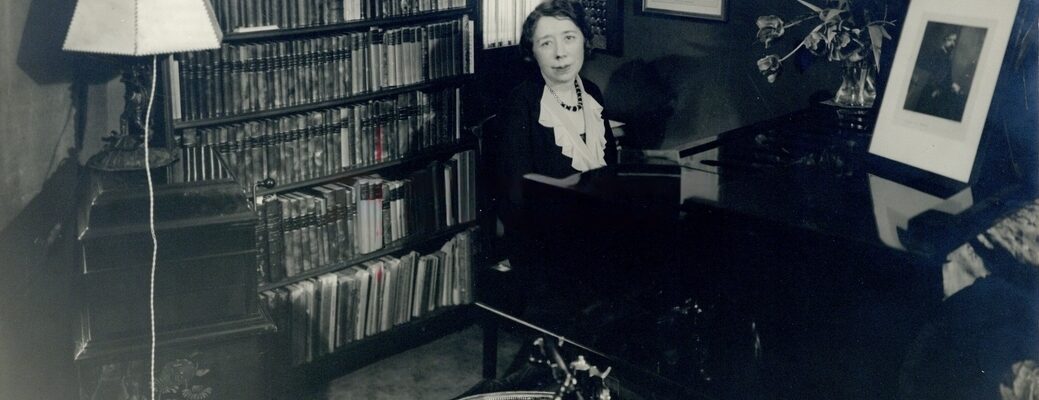The French pianist and pedagogue Marguerite Long was born on November 13, 1874. Over the course of her 91 years, she would become among the most prominent pianists and teachers of her generation.
 Long’s elder sister Claire had a great influence on Marguerite. In 1883, Claire became Professor of Piano at the Nîmes conservatory and a nine-year-old Marguerite was able to enter her class. She received a Prix d’Honneur three years later and then played Mozart’s D Minor Concerto prior to her twelfth birthday. In 1889 she began her studies at the Paris Conservatoire with Henri Fissot, earning her Premier prix in 1891; she additionally studied privately with Antonin Marmontel (the son of the more famous pedagogue Antoine François Marmontel, who is at times incorrectly credited as being her teacher).
Long’s elder sister Claire had a great influence on Marguerite. In 1883, Claire became Professor of Piano at the Nîmes conservatory and a nine-year-old Marguerite was able to enter her class. She received a Prix d’Honneur three years later and then played Mozart’s D Minor Concerto prior to her twelfth birthday. In 1889 she began her studies at the Paris Conservatoire with Henri Fissot, earning her Premier prix in 1891; she additionally studied privately with Antonin Marmontel (the son of the more famous pedagogue Antoine François Marmontel, who is at times incorrectly credited as being her teacher).
She started her long career as a teacher at the Paris Conservatoire in 1906, taking over Louis Diémer’s position in 1920 and remaining there until 1940. Among her famous pupils are Philippe Entremont, Jean Doyen, Jacques Février, Jeanne-Marie Darré, Samson François (who had previously studied with Cortot), Daniel Ericourt, and Nicole Henriot-Schweitzer. A legendary and amusing story: Long had once slapped François in class, and years later she apologized to him, adding that it was the only time she had ever done so, to which he replied, ‘But Madame, what an honour to have been the only one!’
 She opened the Marguerite Long-Jacques Thibaud School in October 1941, and a competition named for the same two musicians began in 1943. She continued to teach late into her long life – ‘My joy in life is work, because it will never betray you’ – but had largely retired by the 1950s even though she set down some recordings early in that decade. On May 4, 1956, she played at a tribute concert where, aged 81, she played Fauré’s Ballade with Charles Munch conducting while the orchestra played a number of works dedicated to her (the concert apparently was recorded but has not seen the light of day). She was invited to be on the jury of the 1966 Tchaikovsky Competition in Moscow but she died beforehand, on February 13, 1966, at the age of 91.
She opened the Marguerite Long-Jacques Thibaud School in October 1941, and a competition named for the same two musicians began in 1943. She continued to teach late into her long life – ‘My joy in life is work, because it will never betray you’ – but had largely retired by the 1950s even though she set down some recordings early in that decade. On May 4, 1956, she played at a tribute concert where, aged 81, she played Fauré’s Ballade with Charles Munch conducting while the orchestra played a number of works dedicated to her (the concert apparently was recorded but has not seen the light of day). She was invited to be on the jury of the 1966 Tchaikovsky Competition in Moscow but she died beforehand, on February 13, 1966, at the age of 91.
 Long is particularly remembered for having known three legendary composers – Debussy, Fauré, and Ravel – and wrote books about her work with each of them. Ravel wrote his iconic Piano Concerto in G Major for Long, having introduced the concept to her by saying, ‘I’m thinking of writing a piano concerto for you. Do you mind if it ends softly with trills?’ As it turns out, that’s how the second movement ended, the final one being far more vivacious and wild; and apparently when Long said to the composer how beautifully the second movement flowed, he responded intensely, ‘I struggled writing every note!’ They toured performing the work together, with Ravel on the podium, and three months to the day after the January 14, 1932 world premiere – April 14 – they recorded it.
Long is particularly remembered for having known three legendary composers – Debussy, Fauré, and Ravel – and wrote books about her work with each of them. Ravel wrote his iconic Piano Concerto in G Major for Long, having introduced the concept to her by saying, ‘I’m thinking of writing a piano concerto for you. Do you mind if it ends softly with trills?’ As it turns out, that’s how the second movement ended, the final one being far more vivacious and wild; and apparently when Long said to the composer how beautifully the second movement flowed, he responded intensely, ‘I struggled writing every note!’ They toured performing the work together, with Ravel on the podium, and three months to the day after the January 14, 1932 world premiere – April 14 – they recorded it.
Or so we thought: in the 1990s it was revealed that Ravel did not in fact conduct the recording but rather Portuguese conductor Pedro de Freitas Branco, whom the composer had coached in conducting the work (and who conducted other orchestral works at the concert during which the first performance took place). Nevertheless, Ravel was present for the recording session and this world premiere account on disc features the pianist for whom he composed it, and is therefore of great historical interest. (The upload below also features Branco’s recording conducting the orchestral version of Ravel’s Pavane pour une infante défunte that filled the final side of the 78rpm disc set.)
Long would rerecord the work 20 years later, this time with George Tzipine conducting, and despite being 78 years old at the time, she plays with remarkable agility for her age and impressive refinement.
Long’s recordings for the Columbia label on both 78s and LP are regrettably scant and inconsistent in their scope. She recorded no solo Ravel, Le tombeau de Couperin being a particularly egregious omission given that she premiered it (as one of the six movements was dedicated to her late husband). She set down a handful of Fauré and Debussy works but no complete cycles (although one might consider Debussy’s two Arabesques to be such), and in fact she recorded more Chopin – but not a great deal – than she did of either Fauré or Debussy. In all of these she demonstrates the epitome of French jeu perlé, with a light touch, evenness of articulation, and great clarity.
Here is her 1935 account of Chopin’s Fantasie-Impromptu Op.66.
Here is a wonderful transfer effected by Tom Jardine (to whom all thanks) of her July 1936 recording of Fauré’s Nocturne No.6 in D-Flat Major Op.63. Her playing in this superb recording is notable for its subtle dynamic shadings, fluid phrasing, and elegant timing.
This link below features other solo Fauré recordings (in addition to the one above) set down between 1933 and 1937: the Barcarolle No.6 in E-Flat Major Op.70, Impromptu in F Minor Op.31, Impromptu in F-Sharp Minor Op.102, Nocturne No.4 in E-Flat Major Op.36, and Nocturne No.6 in D-Flat Major Op.63. Her playing is characterized by unostentatious, direct delivery with clear textures, natural pacing, and legato phrasing.
Long only set down four short solo works by Debussy: the two Arabesques, Jardins sous la pluie, and La plus que lente. Here is a wonderful transfer (effected from 78rpm discs by Tom Jardine) of her July 10, 1930 account of the two Arabesques.
With concerted works, Long was more active in the studio: Mozart’s 23rd, Beethoven’s 3rd and 5th were set down, as was Chopin’s F Minor and then works more associated with her by French composers plus Halffter’s Rapsodia Portugesa.
Below is her June 28-29, 1929 recording of Chopin’s Piano Concerto No.2 in F Minor Op.21 with Philippe Gaubert conducting the Orchestre De La Société Du Conservatoire, Paris. The transfer here was effected by Tom Jardine, with a bit of editing done by yours truly: one of the discs for some reason began with the same orchestral tutti that closed the previous record, so I edited out 20 seconds of this duplication so that the music is now presented as in the score (minus a brief cut in the orchestral introduction, as noted in the booklet accompanying the 78s).
Long’s playing here features clarity of texture, as well wonderful use of rubato and dynamic gradations to shape phrasing.
A fascinating account she left is of a work that is seldom played today: a May 24-25, 1934 recording of the rarely-played Symphonie sur un chant montagnard français for Piano and Orchestra in G Major Op.25 by Vincent d’Indy. Accompanied by Paul Paray and the Orchestre Concerts Colonne, Long plays with a lovely singing melodic line, sparkling tone, attentive pedalling, and a beautifully graded pianissimo – a wonderful reading of a work that should be heard more.
Long made two recordings of Fauré’s Ballade for Piano and Orchestra Op.19, one on April 1, 1930 (a 1929 attempt was not issued) and twenty years later on October 30, 1950 (not 1952 as has often been stated, including in the upload below). Both are featured sequentially below.
Another authorized account that she set down is her April 5, 1935 recording of Milhaud’s Piano Concerto No.1 Op.127, which was dedicated to her and which is conducted here by the composer. Long plays throughout with a clear light touch (what sparkling runs), rhythmic verve, wonderful pedalling, and beautiful dynamic shadings.
Long also set down some chamber music recordings, though not as much as we might like. One overlooked recording is a July 1943 account of Mozart’s Violin Sonata No.42 in A Major, K.526 which she recorded with her colleague Jacques Thibaud the same year that their competition began – a wonderfully vivacious account.
She also recorded both Fauré Piano Quartets, though regrettably no other chamber works by the composer, the 2nd being set down first in 1940 and the second only in 1956, by which time she was generally active in concerts. Her playing is still remarkable at this late stage, as evidenced by the first movement here.
Long’s studio recordings are being impeccably reissued by the APR label, with Volume 1 featuring Fauré and d’Indy and Volume 2 being focused on Chopin, Debussy, Milhaud, and Ravel.
To end this tribute, a few interviews with the great pianist and pedagogue. First, film footage of Long speaking about Fauré (which includes some outtakes prior to the official interview).
And an interview recorded in 1964 prior to her 90th birthday, presented in two parts.
Many thanks to Tom Jardine for the superb transfers of some of the Chopin, Fauré, and Debussy recordings shared (as noted above) and to Frederic Gaussin for the superb photographs and other details shared in this feature.
